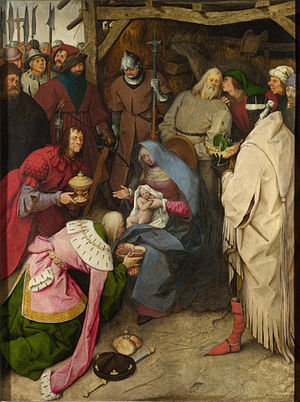The Adoration of the Magi (Bruegel, 1564)

|
| Adoration of the Magi |
|---|
| Pieter Bruegel the Elder , 1564 |
| Oil on oak |
| 112.1 x 83.9 cm |
| National Gallery, London |
The Adoration of the Magi is a painting by Pieter Bruegel the Elder from 1564. It shows the visit of the Wise Men from the Orient to the Holy Family . The oil painting on oak measures 112.1 × 83.9 cm and is part of the National Gallery in London.
There are two other worship scenes from Bruegel: The Adoration of the Magi from around 1556 in the Royal Museums of Fine Arts in Brussels and The Adoration of the Magi in the Snow from 1567 in the Oskar Reinhart Collection in Winterthur .
Description and history
The three wise men from the Orient have just arrived and are handing over their presents to Mary with the baby Jesus . Saint Joseph stands behind Mary . Several other people can be seen, most of them soldiers. In the semi-darkness of the stable, a tethered donkey eats from a feeding trough.
The signature is in the lower right corner: BRVEGEL MDLXIIII. The National Gallery acquired the painting in 1920, the inventory number is NG3556.
interpretation
Mary with the baby Jesus is sitting right in the center of the picture. Her appearance corresponds well to the traditional Catholic ideal, but one of her eyes is covered and her posture is stooped. Moreover, the naked baby Jesus on her lap withdraws fearfully. Two of the kings in the left half of the picture seem very frail, despite their splendid clothes, while the Moorish king on the right in a light coat attracts more attention than Maria. Saint Joseph bows his head towards someone who is whispering something to him. The latter in particular makes the picture appear like the depiction of a nativity scene. According to the requirements of the Counter Reformation, saints had to be clearly distinguishable from other people. A distraction, as in the case of Saint Joseph, also draws attention away from the main subject. This makes it unlikely that the picture was commissioned by the church.
A figure on the very right edge of the picture is wearing eyeglasses. This could be an indication that not everyone present sees the significance of the scene. Bruegel has used eye glasses in other works as a symbol of blindness to the truth. The presence of soldiers in a worship scene is unusual. It can be a reference to the Spanish occupation of the Netherlands.
Individual evidence
- ↑ bundesmuseen.ch: Pieter Brueghel the Elder Ä., The Adoration of the Magi in the Snow, 1563 , accessed September 10, 2017
- ↑ fine-arts-museum.be: L'adoration des mages , accessed on September 10, 2017
- ↑ The painting on the National Gallery's website (provenance and inventory number), accessed on September 10, 2017
- ^ Rose-Marie and Rainer Hagen: Pieter Bruegel the Elder Ä. - Farmers, fools and demons , Cologne: Benedikt Taschen Verlag GmbH 1999 p. 25 ISBN 3-8228-6590-7
- ↑ The painting on the National Gallery's website (glasses and soldiers)
